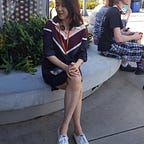For the rest of the day and into the next, I thought about Ruby’s eyes. I had handled the moment badly, I told myself, made her feel ashamed for a small vanity in a life that could afford few vanities. I realized that a part of me expected her and the other leaders to possess some sort of immunity from the onslaught of images that feed every American’s insecurities-the slender models in the fashion magazines, the square-jawed men in fast cars- images to which I myself was vulnerable and from which I had sought protection. When I mentioned the incident to a black woman friend of mine, she state the issue more bluntly. “What are you surprised about?” my friend said impatiently. “That black people still hate themselves?” No, I told her, it wasn’t exactly surprised that I was feeling. Since my first frightening discovery of bleaching creams in Life magazine, I’d become familiar with the lexicon of color consciousness with the black community-good hair, bad hair; thick lips, or thin; if you're light, you’re all right, if you're black, get back. In college, the politics of black fashion, and the questions of self-esteem that fashion signified, had been frequent, if delicate, the topic of conversation for black students, especially among the women, who would smile bitterly at the sight of the militant brother who always seemed to be dating light-skinned girls-and tongue-lash any black man who was foolish enough to make a remark about black women’s hairstyles. Mostly, I had kept quiet when this subject was broached, privately measuring my own degree of infection. But I noticed that such conversations rarely took place in large groups, and never in front of whites. Later, I would realize that the position of most black students in predominantly white colleges was already too tenuous, our identities too scrambled, to admit to ourselves that our black pride remained incomplete. -P.197, September 30, 2021
